
Beetles are a group of insects that form the order Coleoptera, in the superorder Endopterygota. Their front pair of wings are hardened into wing-cases, elytra, distinguishing them from most other insects. The Coleoptera, with about 400,000 species, is the largest of all orders, constituting almost 40% of described insects and 25% of all known animal life-forms; new species are discovered frequently. The largest of all families, the Curculionidae (weevils), with some 83,000 member species, belongs to this order. Found in almost every habitat except the sea and the polar regions, they interact with their ecosystems in several ways: beetles often feed on plants and fungi, break down animal and plant debris, and eat other invertebrates. Some species are serious agricultural pests, such as the Colorado potato beetle, while others such as Coccinellidae eat aphids, scale insects, thrips, and other plant-sucking insects that damage crops.

The family Scarabaeidae, as currently defined, consists of over 30,000 species of beetles worldwide; they are often called scarabs or scarab beetles. The classification of this family has undergone significant change in recent years. Several subfamilies have been elevated to family rank, and some reduced to lower ranks. The subfamilies listed in this article are in accordance with those in Bouchard (2011).

Khepri is a scarab-faced god in ancient Egyptian religion who represents the rising or morning sun. By extension, he can also represent creation and the renewal of life.

Kheper is a subgenus of Scarabaeus: the typical genus of scarab beetles in the tribe Scarabaeini. The genus name honors the god Khepri in the ancient Egyptian religion, who is depicted as having a scarab for a head. Kheper can be found on the border between Botswana, Namibia, and South Africa in the arid sand dunes. This genus of scarab beetles share a family with the oldest and most revered scarab beetles, the Scarabaeus sacer.

Dung beetles are beetles that feed on feces. Some species of dung beetles can bury dung 250 times their own mass in one night.
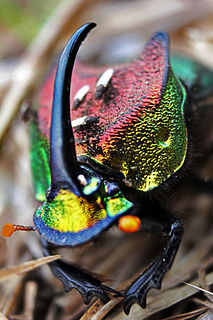
Phanaeus vindex, the rainbow scarab, is a North American dung beetle, with a range from the eastern US to the Rocky Mountains. The head is a metallic yellow color, and males have a black horn which curves backward toward the thorax. Both sexes have yellow antennae which can retract into a ball on the underside of the head. The thorax is a shiny coppery color, with yellow or green on the sides. The abdomen is metallic green. The underbelly is black and green. Body length is about 2–3 cm (0.8-1.2 in) long.

Ochodaeidae, also known as the sand-loving scarab beetles, is a small family of scarabaeiform beetles occurring in many parts of the world.

The scarab beetle subfamily Scarabaeinae consists of species collectively called true dung beetles. Most of the beetles of this subfamily feed exclusively on dung. However, some may feed on decomposing matter including carrion, decaying fruits and fungi. Dung beetles can be placed into three structural guilds based on their method of dung processing namely rollers, dwellers and tunnelers Dung removal and burial by dung beetles result in ecological benefits such as soil aeration and fertilization; improved nutrient cycling and uptake by plants, increase in Pasture quality, biological control of pest flies and intestinal parasites and secondary seed dispersal. Well-known members include the genera Scarabaeus and Sisyphus, and Phanaeus vindex.

Aphodiinae is a subfamily of the scarab beetle family, Scarabaeidae. Members of this subfamily are known commonly as the small dung beetles and many, but not all, are dung beetles. These beetles are found worldwide.

Scarabaeus sacer, common name sacred scarab, is the type species of dung beetles in its geenus and the family Scarabaeidae.
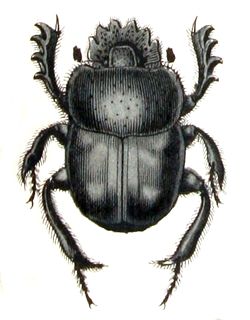
The genus Scarabaeus consists of a number of Old World dung beetle species, including the "sacred scarab beetle", Scarabaeus sacer and typical of the tribe Scarabaeini. These beetles feed exclusively on dung, which they accomplish by rolling a piece of dung some distance from where it was deposited, and burying it in order to feed on it underground. They also prepare food for their larvae by excavating an underground chamber, and filling it with balls that have eggs laid in them. The growing larva feeds upon the dung ball, pupates, and eventually emerges as an adult.
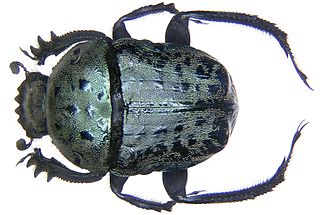
Allogymnopleurus is a genus of scarab beetles in the tribe Gymnopleurini. It includes 20 species; 17 are restricted to the Afrotropics, one is Afrotropical/Palearctic, and two Oriental.

Eurysternus is a genus of Scarabaeinae or dung beetles in the family Scarabaeidae. It is normally placed in the Oniticellini, although some authors consider it the single genus in the tribe Eurysternini (e.g.). It is restricted to the Neotropics and includes 53 recognized species.
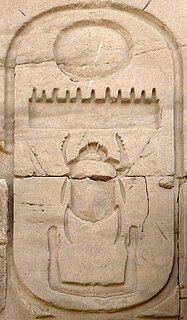
Insects have long been used in religion, both directly and as images or symbols.
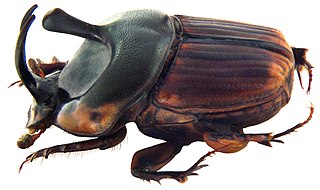
Oniticellini are a tribe of scarab beetles, in the true dung beetle subfamily (Scarabaeinae). Nearly all species of this tribe feed on and nest in dung, mainly that of large herbivores. Most are tunnelers; dung is buried at the ends of tunnels dug below a dropping, and used as food by both adults and larvae; others, known as dwellers make brood cavities within or just beneath the dung.

Deltochilini is a tribe of scarab beetles, in the dung beetle subfamily (Scarabaeinae). Members of this group vary widely in size and shape, but were thought to be derived from an ancient ball-rolling lineage. The outer edges of the front tibiae have less than four teeth. The grouping based on these characteristics has, however, been found to have little phylogenetic validity, and the placement of several genera in the tribe is likely to change.
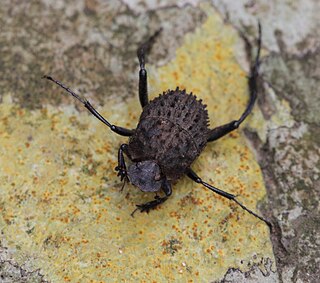
Sisyphini is a tribe of scarab beetles, in the dung beetle subfamily (Scarabaeinae), but it may now be combined with the Scarabaeini. The middle and hind legs are very long; the relatively short body is laterally compressed and has flattened sides. Relative to other dung beetles they are of small to moderate size.
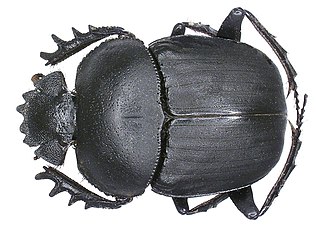
Scarabaeus ambiguus is a species of Old World dung beetles. This beetle rolls up a ball of dung before laying eggs on it and burying it.
Garreta smaragdifer is a species of dung beetle native to India and Sri Lanka.
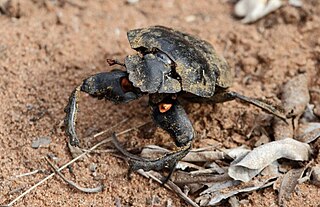
Pachylomera is a genus of dung beetle from the family Scarabaeidae and tribe Scarabaeini, with records from Africa south of the equator.



















